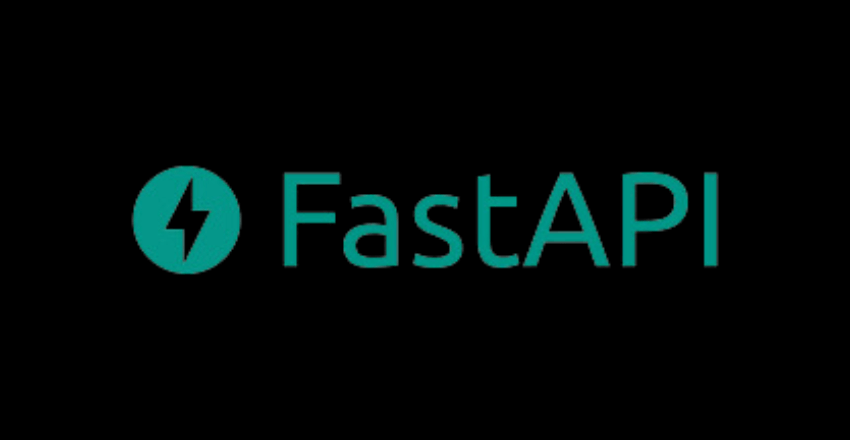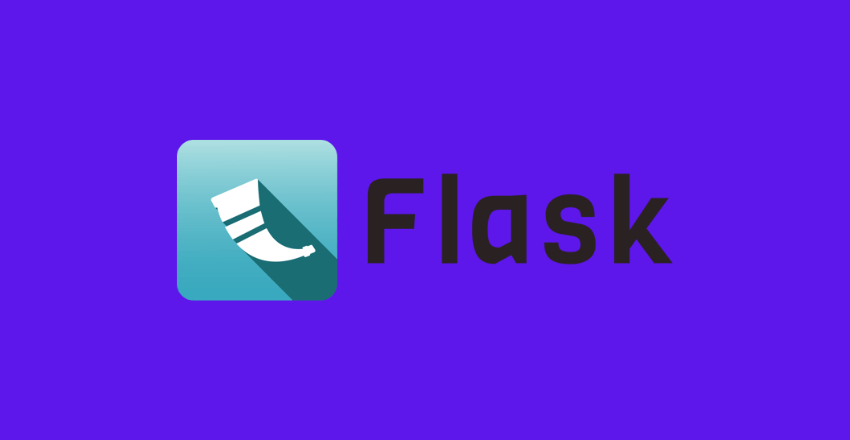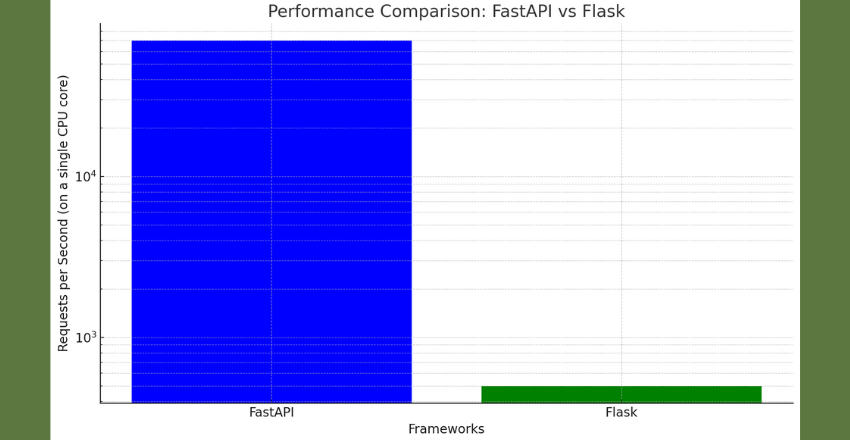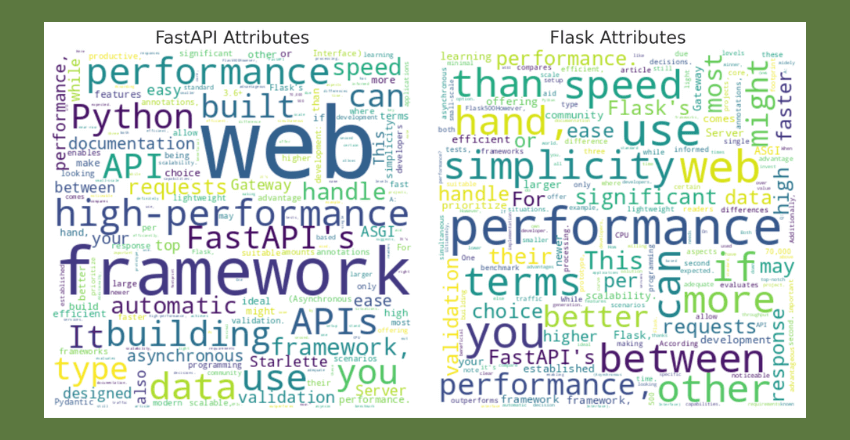Are you comparing FastAPI vs Flask for your next web development project? Both frameworks have their unique strengths, captivating developers across the spectrum. Understanding the nuances is pivotal as you navigate the evolving landscape of Python web frameworks.
Choosing the right web development framework is crucial in delivering efficient and reliable web applications. Currently, two of the most popular frameworks in the Python community are FastAPI and Flask.
Both frameworks have their strengths and weaknesses, making it essential to evaluate them based on specific requirements.
Let’s dive into the comparison of FastAPI and Flask.
Key Takeaways

Here’s a side-by-side comparison visualization of the key takeaways for FastAPI (in blue) and Flask (in green)
What is FastAPI?

FastAPI is a modern web framework built for high-performance web APIs. It is designed to be easy to use, productive while also being fast and efficient. FastAPI is built on top of the Starlette framework, a lightweight ASGI (Asynchronous Server Gateway Interface) framework for building high-performance asyncio services.
One of the critical features of FastAPI is its automatic generation of interactive API documentation. FastAPI is built with the OpenAPI specification in mind, allowing it to generate detailed API documentation based on your code automatically. Documenting your API can save you a lot of time and effort.
Key features of FastAPI include:
- Fast: High-performance async support powered by Starlette
- Easy: Designed to be easy to use and learn
- Automatic: Automatic generation of OpenAPI and JSON Schema documentation
- Standards-based: Based on (and fully compatible with) the open standards for APIs: OpenAPI and JSON Schema
- Pythonic: Based on standard Python type annotations and async/await
- Short: Minimize code duplication: Multiple features, including parameters, validation, documentation, and routing, are handled in a single function declaration
“FastAPI is easy to use, high-performance, and has automatic API documentation. It’s definitely one of the top web frameworks for building APIs in Python right now.
What is Flask?

Flask is a popular web framework written in Python. It was first released in 2010, and since then, it has received much attention from developers and the Python community. Flask is known for its simplicity, flexibility, and extensive documentation, which makes it an excellent choice for building small to medium-sized web applications.
One of the primary advantages of Flask is its minimalist approach, which allows developers to build applications quickly and with minimal overhead. Flask provides only the essential tools for creating web applications, such as routing, request handling, and response generation.
However, it can be extended with many third-party libraries and extensions that provide additional functionality.
Flask is also highly configurable, allowing developers to tailor it to their needs. It provides configuration options for various aspects of the application, such as debugging, testing, and security. Additionally, Flask supports templating engines, making building dynamic and responsive web pages accessible.
Flask is a lightweight, flexible web framework well-suited for small to medium-sized projects. It is easy to learn and use, and its extensive documentation and large community make it an excellent choice for developers who want to build web applications quickly and efficiently.
Performance Comparison
One of the most significant differences between FastAPI and Flask is their performance. While both frameworks are lightweight and efficient, FastAPI outperforms Flask regarding speed and response time.
Here’s the performance comparison between FastAPI and Flask:

The bar chart displays the number of requests per second each framework can handle on a single CPU core.
From the chart, it’s clear that FastAPI can handle significantly more requests per second than Flask. This difference can be attributed to FastAPI’s asynchronous programming and type annotations.
According to benchmark tests, FastAPI can handle 70,000 requests per second on a single CPU core, while Flask can handle only 500 requests per second. This significant difference is due to FastAPI’s asynchronous programming and type annotations, allowing faster data validation and processing.
| Framework | Requests per second |
|---|---|
| FastAPI | 70,000 |
| Flask | 500 |
However, it’s important to note that the performance advantage of FastAPI is most noticeable in scenarios where high levels of simultaneous traffic are expected. Flask may still be a suitable choice for smaller-scale projects and offer adequate performance.
Additionally, Flask’s simplicity and ease of use can be advantageous in certain situations. For example, if you are building a small-scale API or a prototype, Flask’s light footprint and minimal setup requirements may be more beneficial than FastAPI’s higher performance capabilities.
Features of FastAPI
FastAPI is a modern web framework that allows developers to build APIs with high performance, scalability, and ease of use.
Here are some of the key features that make FastAPI stand out in web development:
Fast
As the name suggests, FastAPI is built with speed in mind. It is built on the Starlette framework, designed to handle large amounts of asynchronous I/O web requests and responses efficiently.
FastAPI achieves near-raw performance by leveraging the power of Python 3.6+ type annotations and Pydantic data validation.
Easy to use
FastAPI is designed to be easy to use and understand. Its intuitive code structure and automatic API documentation make it simple to start building APIs.
The framework includes parameters and body validation, automatic generation of OpenAPI documentation, and interactive API documentation with Swagger UI.
Type annotations
FastAPI takes advantage of Python 3.6+ type annotations that allow you to clearly define the input and output data types of your API endpoints. This improves code readability and enables high-performance validation of data being passed to and from your API.
Asynchronous support
FastAPI is built with the modern asynchronous programming paradigm in mind. It handles asynchronous code execution like a breeze, allowing your API to handle large concurrent connections efficiently.
Automatic code generation
FastAPI supports automatic code generation for ORM models, Pydantic models, and even OpenAPI definitions. This feature significantly speeds up the development process and reduces code duplication.
FastAPI is a powerful web framework with rich features and cutting-edge technology that makes building APIs a breeze. Whether you’re a seasoned developer or just starting with web development, FastAPI can help you easily build scalable, high-performance APIs.
Features of Flask
Flask is a micro web framework that is easy to use and has a simple syntax. Its minimal structure allows developers to customize the application to their needs. Flask provides several features to make web development easier and quicker. Below are some of the key features and functionalities that Flask offers.
Routing
Flask features an efficient routing system making it easy to map URLs to views. Its simple syntax for routing allows for quick customization of URLs and HTTP methods. Developers can easily manage URLs with different parameters using Flask’s intuitive routing system.
Templates
Flask comes with a built-in templating engine called Jinja2. It allows developers to separate the design from the application’s logic and generate dynamic HTML pages by incorporating variables, filters, and control structures. It makes dynamic web development more manageable and reduces the required code.
Web Server Gateway Interface (WSGI) Support
Flask has built-in support for WSGI, a standard interface between web servers and web applications. WSGI allows the web server, such as Apache or Nginx, to communicate with the Flask application, making deploying the application on a web server easier.
Extensions
Flask has a large number of extensions that provide additional functionality to developers. These extensions are easy to integrate with the Flask application and offer many features such as authentication, database integration, and caching.
Debugging Tools
Flask provides a built-in debugging tool that makes it easy for developers to debug their applications within the browser. It also provides a development server that allows developers to test their applications locally before deployment.
RESTful Request Dispatching
Flask allows for easy development of RESTful APIs. It provides a request dispatcher that maps URLs to RESTful resource methods, such as GET, POST, PUT, and DELETE, allowing for easy creation of RESTful APIs.
These visualizations provide a quick, qualitative overview of FastAPI vs Flask

Here are the word clouds highlighting the most frequently mentioned attributes of FastAPI (on the left) and Flask (on the right) based on the content from the article.
Word clouds visually represent the frequency of words by varying the size of each word. Larger words were mentioned more frequently about each framework.
From the word clouds:
- For FastAPI, terms like “performance,” “high,” “web,” and “APIs” are predominant, indicating its strengths in high-performance API development.
- For Flask, terms like “use,” “simplicity,” “small-scale,” and “light” are more pronounced, suggesting its ease of use and suitability for smaller, more straightforward projects.
Use Cases for FastAPI
FastAPI is a versatile web framework with several features, making it suitable for many use cases.
However, it excels in the following scenarios:
- API development: FastAPI’s asynchronous capabilities, type annotations, and automatic OpenAPI documentation make it ideal for creating high-performance APIs that can handle large amounts of traffic.
- Real-time applications: With its support for WebSockets and event-driven programming, FastAPI is well-suited for real-time applications such as chat apps, gaming platforms, and collaborative tools.
FastAPI’s performance and ease of use make it an excellent choice for developers building scalable, high-performance web applications.
Use Cases for Flask
Flask is a web framework known for its flexibility and easy-to-use nature. Its lightweight design and simple syntax make it popular for building small to medium-sized web applications.
Here are some use cases where Flask excels:
- Small-scale web applications: Flask’s lightweight design and easy-to-use syntax make it an ideal choice for building simple web applications, such as personal blogs or company websites.
- API development: Flask’s flexibility and ease of use make it a popular choice for building APIs. Its simple design allows developers to quickly and easily build RESTful APIs that other applications or services can use.
- Prototyping: Flask’s simplicity and ease of use make it ideal for building prototypes. Its lightweight nature allows developers to quickly build and test ideas without getting bogged down in complex design or implementation details.
“Flask’s flexibility and ease of use make it a popular choice for building APIs.”
Flask is an excellent choice for developers who want a lightweight, easy-to-use web framework that can be used for various small to medium-sized web applications.
Conclusion – FastAPI vs Flask

Both FastAPI and Flask have advantages and are widely used in web development. FastAPI is a newer framework offering top-notch performance and features like automatic data validation and documentation generation.
On the other hand, Flask is a more established framework with a lower learning curve and a larger community of developers.
Regarding performance, FastAPI is the clear winner, offering faster response times and higher throughput than Flask. However, if you prioritize ease of use and simplicity over performance, Flask might be the better choice for your web development project.
Comparing FastAPI vs Flask: Common Problems and Solutions
When diving into Python web frameworks, the debate often centers around FastAPI vs Flask. Both are remarkable in their own right, but drawing direct comparisons can lead to several misconceptions.
Let’s dissect three prevalent issues that arise when comparing FastAPI vs Flask.
1. Overemphasis on Performance Metrics
- Problem: One of the most cited differences when comparing FastAPI vs Flask is performance. While FastAPI often outshines Flask in raw speed due to its asynchronous capabilities, solely focusing on this can be misleading.
- Consequence: This narrow perspective can lead developers to overlook Flask’s strengths, such as its simplicity and vast ecosystem. It can also falsely imply that FastAPI is always the superior choice.
- Solution: It’s essential to consider the broader context. Determine the specific needs of your project. If you’re building a small application or prototype, Flask’s ease of use might outweigh the performance benefits of FastAPI.
2. Overlooking Architectural Differences
- Problem: FastAPI’s asynchronous nature and Flask’s synchronous approach are often glossed over. Yet, this difference fundamentally impacts how you design and scale applications.
- Consequence: Developers might find themselves ill-prepared when encountering challenges related to concurrency and scaling, leading to suboptimal application architectures.
- Solution: Invest time in understanding the underpinnings of each framework. Recognize when to leverage FastAPI’s asynchronous capabilities and when Flask’s straightforward approach is more apt.
3. Generalizing Use Cases
- Problem: Both frameworks are versatile, but generalizing them as interchangeable for all use cases is a common pitfall.
- Consequence: This can lead to using a sledgehammer for a thumbtack job. For instance, using FastAPI for a simple, static website might be overkill, while opting for Flask for a high-concurrency API might introduce bottlenecks.
- Solution: Align the framework’s strengths with your project’s requirements. If you need robust concurrency support and automatic data validation, FastAPI is your go-to. For more straightforward projects where rapid development is key, Flask shines.
While the debate around FastAPI vs Flask will persist, understanding these pitfalls ensures you make decisions grounded in knowledge rather than misconceptions.
Here’s a table summary of the key takeaways from the article on FastAPI vs. Flask:
| Key Points | FastAPI | Flask |
|---|---|---|
| Web Development Frameworks | The leading choice in the Python community | The leading choice in the Python community |
| Performance | Handles 70,000 requests/sec on a single CPU (due to asynchronous programming & type annotations) | Handles 500 requests/sec on a single CPU |
| Use Cases | Ideal for high concurrent traffic scenarios | Suitable for smaller-scale projects |
| Simplicity vs. Performance | High performance for larger-scale applications | Known for simplicity & ease of use |
| Community Support | Modern framework with a growing community | Long-standing with a larger developer community |
| Underlying Technologies | Operates on ASGI | Relies on WSGI |
| Decision-making | Best for those prioritizing speed & willing to adopt a newer framework | Best for those valuing simplicity & an established community |
This table provides a side-by-side comparison of the main points related to FastAPI and Flask
FAQs – FastAPI vs Flask
1. How do FastAPI and Flask handle data validation and serialization?
Answer: FastAPI uses Pydantic for data validation and serialization. This allows developers to define models using Python type annotations, ensuring type safety and automatic validation.
Flask, on the other hand, doesn’t have a built-in data validation and serialization mechanism. Developers often rely on extensions like Marshmallow or WTForms.
Example: With FastAPI, a simple model can be defined as:
from pydantic import BaseModel
class Item(BaseModel):
name: str
price: floatFor Flask with Marshmallow:
from marshmallow import Schema, fields
class ItemSchema(Schema):
name = fields.Str(required=True)
price = fields.Float(required=True)Pro Tip: Using type annotations with FastAPI provides automatic validation and enhances editor support, offering features like auto-completion and type-checking.
2. How do the two frameworks differ in terms of asynchronous support?
Answer: FastAPI has native support for asynchronous operations, enabling developers to handle many simultaneous connections efficiently. This is beneficial for I/O-bound operations.
Flask, being based on WSGI, doesn’t natively support asynchronous handlers. While there are workarounds, they aren’t as efficient as FastAPI’s ASGI-based approach.
Example: In FastAPI, you can easily define an asynchronous route with the async keyword:
from fastapi import FastAPI
app = FastAPI()
@app.get("/")
async def read_root():
return {"message": "Hello, World"}Pro Tip: If your application requires real-time operations or has many simultaneous connections, consider leveraging FastAPI’s asynchronous capabilities.
3. How does routing differ between FastAPI and Flask?
Answer: Both frameworks offer intuitive routing mechanisms. However, FastAPI routes are type-safe due to using Pydantic models and Python-type hints.
Example: In FastAPI:
@app.get("/items/{item_id}")
async def read_item(item_id: int):
return {"item_id": item_id}In Flask:
@app.route('/items/<int:item_id>')
def read_item(item_id):
return {"item_id": item_id}Pro Tip: With FastAPI, using type hints in routes provides automatic validation, ensuring that the data matches the expected type.
4. How do FastAPI and Flask handle API documentation?
Answer: FastAPI automatically generates interactive API documentation using Swagger UI and ReDoc. This is possible due to the use of Pydantic models and type hints.
Flask doesn’t have built-in API documentation. Developers often use extensions like Flask-RESTPlus or Flasgger to achieve similar functionality.
Pro Tip: FastAPI’s automatic documentation is an excellent tool for developers and aids in client integration, ensuring clear communication about API contracts.
5. Can I migrate my existing Flask application to FastAPI?
Answer: It’s possible to migrate, but the process isn’t always straightforward. The frameworks have different architectures, especially with FastAPI’s emphasis on asynchronous operations and type safety. However, since both frameworks are in Python, shared logic and utilities can often be reused.
Pro Tip: Instead of a full migration, consider building new components or microservices using FastAPI while keeping the existing Flask application intact. This hybrid approach can balance leveraging FastAPI’s advantages and avoiding the risks of a full migration.
Lydia is a seasoned technical author, well-versed in the intricacies of software development and a dedicated practitioner of Python. With a career spanning 16 years, Lydia has made significant contributions as a programmer and scrum master at renowned companies such as Thompsons, Deloit, and The GAP, where they have been instrumental in delivering successful projects.
A proud alumnus of Duke University, Lydia pursued a degree in Computer Science, solidifying their academic foundation. At Duke, they gained a comprehensive understanding of computer systems, algorithms, and programming languages, which paved the way for their career in the ever-evolving field of software development.
As a technical author, Lydia remains committed to fostering knowledge sharing and promoting the growth of the computer science community. Their dedication to Python development, coupled with their expertise as a programmer and scrum master, positions them as a trusted source of guidance and insight. Through their publications and engagements, Lydia continues to inspire and empower fellow technologists, leaving an indelible mark on the world of scientific computer science.


![15 Most Contributed Python Projects on GitHub [Stats]](https://hirepythondeveloper.com/wp-content/uploads/2024/03/15-Most-Contributed-Python-Projects-on-GitHub-Stats-1-150x150.png)




